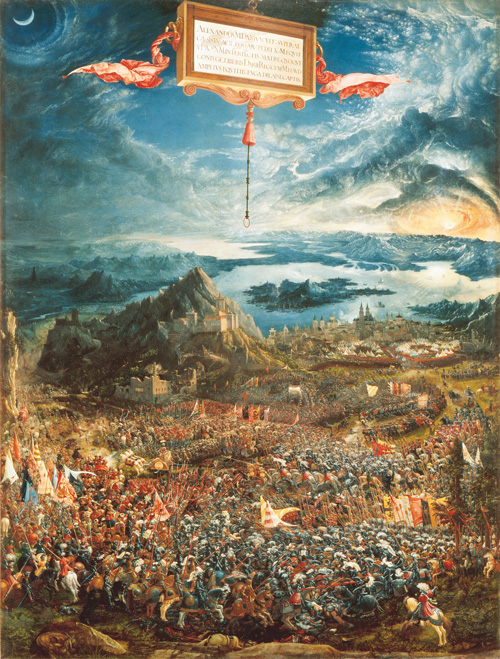
Jonathan Jones is an art writer for The Guardian. In 2010, he wrote an article entitled, “Why Albrecht Altdorfer’s masterpiece gives me nightmares.” Jones was referring to German Renaissance painter, Albrecht Altdorfer (c. 1480-1538). Altdorfer was a major representative of the Donau (or Danube) School, a group of artists from Bavaria and Austria who were the first to paint “pure” landscape. By “pure” landscape, I refer to the painting of landscape as an independent genre, often devoid of figures. The Donau painters set Biblical and historical subjects against landscape backgrounds of vivid and almost expressionistic color.
The influence of Matthias Grünewald was strong, as was that of Peter Brueghel, the Elder. But the Donau painters explored a style known as Weltlandschaft (World Landscape). Their paintings depicted an imaginary panoramic landscape seen from a highly elevated view. The subjects are often dwarfed by the immense landscape. Altdorfer painted both Landscape with a Footbridge (1516) and Danube Landscape near Regensburg (1522) with no figures at all. His were the first “pure” landscapes since antiquity.
The work of the Donau School signaled a break with the high Northern Renaissance style. Donau work was malerish (painterly), indicating the opposite of the more accepted linear style, but these paintings were far ahead of their time in their emotionalism and expressionistic use of color. Painterly style is marked by visible brushstrokes, vivid color, and dynamism that exhibits highly charged emotion and expressiveness.
Albrecht Altdorfer, known as a painter, engraver and architect, made his early mark as an engraver in the style of Dürer, and as the town architect of Regensburg. Following a 1511 journey south along the Danube and into the Alps, he turned to landscape painting, having been deeply influenced by the mountainous scenery. As his style developed, Altdorfer reached the conclusion that the human figure should not disrupt nature, but should imitate it or participate in its processes. In 1529, Altdorfer completed The Battle of Alexander at Issus. The painting was the result of a commission by William IV, Duke of Bavaria. It was to be one of a series of paintings for the Duke’s residence at Munich.

It is surmised that Altdorfer used Hartmann Schedel’s Nuremberg Chronicle, a world history of 1493, as his historical reference. Altdorfer makes the same mistakes, especially geographically, in his painting as Schedel does in his historical account of the battle! Anachronism is the key to the painting. Alexander’s army is portrayed in 16th-century battle armor, while the soldiers of Darius are seen in typical Turkish dress. Women are included in the battle scene, looking as if they are en route to a social gathering. There is a lack of the sense of time. Altdorfer saw no difference between 333 BCE and 1529. And this may well be the true meaning of the painting. In 1529, the Ottoman Turks, under the leadership of Suleiman, laid siege to Vienna. This was their first attempt to capture the Austrian city. The parallels between the Battle of Issus and the Siege of Vienna could not have been lost on Altdorfer.
The Battle of Alexander at Issus is an oil painting on a limewood panel, portraying the moment of Alexander’s victory. It is a large vertical work. Thousands of soldiers surround the central action. Alexander bears down upon a fleeing Darius, fearfully looking over his shoulder from his chariot. Alexander’s army is clothed in blue and full armor, while Darius’ soldiers wear red Turkish clothing. The Imperial army repels the Turks as the vast number of soldiers blends into the landscape, making the landscape just as important as the battle.
And what a landscape it is! The viewer looks south from a great height over the entire Mediterranean, from modern Turkey and over Cyprus to the mouths of the Nile and the Red Sea. The view extends beyond Cyprus to the coast of Egypt and the Sinai Peninsula. Even the curvature of the earth is depicted, probably the first to do so, as the sun sets behind the land. The sky dominates more than 1/3 of the painting. Altdorfer’s sky is reminiscent of Grünewald’s Heavenly Host above the Virgin and Child, a part of the Isenheim Altarpiece. Color is vivid and almost surreal. The reds and browns of the battle scene give way to the bright blues of the water and sky. A setting sun baths the landscape in light. The sun, actually too large for the painting, symbolizes power and glory in Alexander’s victory. It shines brightly on the Western landscape while the Eastern falls in shadow. A small crescent moon is shown on the opposite side, representing the Eastern or Turkish, defeated. A large tablet hangs from the sky, recounting the defeat of Darius and the loss of life—Persian lives lost at 100,000 infantry and 10,000 + cavalry.
There is a strong religious undercurrent in Altdorfer’s painting. Prophecies from the Book of Daniel abound, especially in the depiction of the sky. Of course, there was ample concern about great calamities and a coming apocalypse during the 16th century. None of this could have escaped the attention and concern of Altdorfer, a devout Catholic and strong supporter of the church.
So why does this painting strike such a chord of terror in Jonathan Jones? Jones recounts that, in Altdorfer’s painting, “two vast armies fight for the future of the world.” He sees the work as the classic conflict and inevitable confrontation between East and West. “This is war as unholy spectacle, but where is the humanity? Where is the pity?” Jones acknowledges that war is and should be depicted in painting, but he is immediately aware of the timelessness of this particular subject and the manner in which Altdorfer presents it to the viewer. The painting “feasts so magnificently on the inhuman slaughter it portrays.” The conflict between East and West is ever present in Jones’ mind as he studies the painting. Perhaps also the inevitable confrontation. He reminds the reader of Hitler’s unconcern for humanity, pointedly passing on the fact that Hitler’s museum is just down the corner from the Alte Pinakothek in the Kunstareal of Munich where Altdorfer’s painting hangs. Jones concludes, “This painting anticipates the worst of 20th-century fascism.” And, as we watch the daily news reports, perhaps this is indeed the “scariest painting in the world!”









